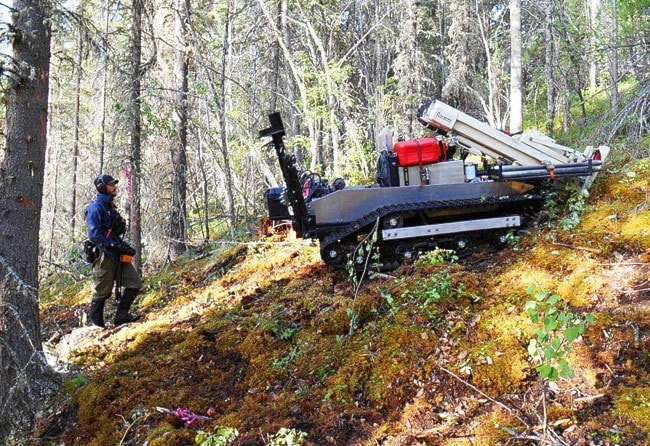A small business with a big idea is expanding beyond the Yukon, sending drones and remote-controlled machines to mineral exploration sites across Canada.
The owners of Dawson-based GroundTruth Exploration, Tao Henderson and Isaac Fage, have pioneered a new method for finding gold, zinc, and other minerals without cutting down swaths of trees and digging up piles of dirt.
The company has been working with clients in the Yukon since it was founded in 2010, but now it’s scooped up contracts in British Columbia and Nunavut as well.
“It’s grown quite nicely,” Henderson said. “We’ve been very busy with clientele.”
Henderson claims his company’s technique is faster and cheaper than conventional mineral exploration - and that it leaves a much smaller footprint.
The process starts with a drone, which GroundTruth uses to capture high-resolution images of an exploration site. Those images provide detailed topographic information that can be used to hone in on specific areas worth exploring more closely.
Next, the company uses electrodes to pinpoint areas that might be rich in certain types of minerals. A cable extended along the ground, with electrodes pushed into the soil every five metres, gives readings of the ground’s resistivity at each point. Those readings indicate which minerals might be present.
Henderson said a similar technique has been used to find aquifers in places like Texas and Florida. But using it to find mineral deposits is much less common.
Once the team has located the specific areas they want to explore, they bring in the GT probe - a hydraulic drill mounted on a wireless, remote-controlled, rubber-tracked vehicle designed and built by Henderson.
The probe drills to the bedrock, usually two or three metres down. There, it hammers away at the rock, chipping off pieces that can be analyzed for mineral content.
“It’s like a giant jack-hammer,” Henderson explained.
The GT probe is a real departure from the conventional sampling method, which usually involves cutting lines through the forest and digging trenches hundreds of metres long. Henderson’s invention can maneuvre through the trees without needing a path, and leaves small holes instead of large trenches.
Finally, when the team finds valuable minerals near the surface, GroundTruth sends in a rotary air blast (RAB) drill to collect deeper samples, down to 100 metres in the bedrock. This drill, too, is mounted on a remote-controlled, tracked platform that can be guided through the forest.
The RAB drill is not a new invention, but it’s rarely been used for mineral exploration in Canada. Instead, larger diamond drills are generally used. But diamond drills have to be moved by helicopter from one site to another, and they have to be set up on cleared pads in the forest. They also use large amounts of water. Henderson said the RAB drill doesn’t need any of that.
“We’ve set our standard for low-impact exploration methods,” he said. “We want to leave a low footprint in the field. We want to leave it the way we found it.”
Henderson and Fage developed their new exploration techniques alongside Yukon prospector Shawn Ryan and his partner, Cathy Wood. But Henderson is the technical mastermind.
Originally from Ontario, Henderson used to work as a mechanic and welder. Finding creative solutions to problems is second nature for him.
“I just had a natural knack for being able to build things, invent things, modify things,” he said.
He arrived in Dawson 10 years ago, and eventually formed his own exploration company, Talus Exploration Ltd., which offered standard trenching services to mining companies.
But he quickly realized the system could be improved. Not only does conventional mining exploration leave deep scars on the land, he said, but it’s also expensive and time-consuming. That’s when he began designing his new ideas with Fage and Ryan “on the back of a napkin.”
Henderson said his GT probe can cover 150 metres in a day, while trenching covers less than half that distance. He also said RAB drilling costs two-thirds as much as diamond drilling, in part because the drill doesn’t need to be moved around by helicopter.
But a major source of savings is in remediation. Trenches have to be backfilled once conventional exploration is finished, and that takes time, money, and manpower.
“If I use GroundTruth, I don’t have to do remediation,” said Peter Tallman, president and CEO of Klondike Gold, a junior mining company exploring near Dawson City. “And that remediation… can double the total cost.”
Klondike Gold has been working with GroundTruth for the last five years, and Tallman said the company is now doing most of their contracting.
GroundTruth still doesn’t provide everything the company needs. Tallman said he needs a probe that can collect entire rocks, not just rock chips. But he said Henderson has promised him he’ll be able to do that within a couple of months.
“What I’m trying to do is push him a bit further,” Tallman said. “Tao’s crazy enough to be able to figure it out.”
Tallman said the fact that GroundTruth is now getting contracts outside the territory is a testament to what the company has created. He said most miners prefer to hire local contractors, so it’s hard for a small company to become known beyond their own community.
“(Henderson) has invented something that is truly unique in the exploration world,” he said. “They’re doing what… we should all be trying to do, which is to minimize the impacts in the woods.”
But for Henderson, the contracts in Nunavut and B.C. are just the beginning of what he hopes to achieve. He wants to expand GroundTruth’s services outside Canada, to South America and beyond.
“It’s just about getting the word out,” he said. “To see our drills on surfaces in seven continents would be nice.”
Contact Maura Forrest at
maura.forrest@yukon-news.com
